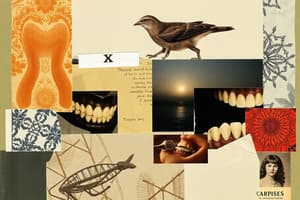Podcast
Questions and Answers
What is the most easily quantified objective criterion for the mandibular edentulous ridge?
What is the most easily quantified objective criterion for the mandibular edentulous ridge?
- Bone height-mandible (correct)
- Maxillomandibular relationship
- Residual ridge morphology-maxilla
- Muscle attachments-mandible
Which factor is NOT mentioned as affecting the results of a radiographic survey of residual bone height measurement?
Which factor is NOT mentioned as affecting the results of a radiographic survey of residual bone height measurement?
- Magnification of panoramic machines
- Radiographic techniques
- Vertical height of the mandible
- Patient age (correct)
Which of the following statements about the classification system is true?
Which of the following statements about the classification system is true?
- It requires no monitoring or revision.
- It is based solely on subjective variables.
- It ranks diagnostic criteria by their significance.
- It is organized by objective criteria. (correct)
What does the continued decrease in bone volume NOT affect?
What does the continued decrease in bone volume NOT affect?
What was established about the loss of denture supporting structures?
What was established about the loss of denture supporting structures?
According to Atwood’s description, what is the nature of alveolar bone loss?
According to Atwood’s description, what is the nature of alveolar bone loss?
Which declared factor is NOT listed as a consequence of chronic debilitation from complete edentulism in the mandible?
Which declared factor is NOT listed as a consequence of chronic debilitation from complete edentulism in the mandible?
What is the organization of the diagnostic criteria primarily based upon?
What is the organization of the diagnostic criteria primarily based upon?
What does Class I in the ACP classification system represent?
What does Class I in the ACP classification system represent?
Which of the following is NOT a category in the ACP classification system?
Which of the following is NOT a category in the ACP classification system?
What is a potential benefit of the classification system for complete edentulism?
What is a potential benefit of the classification system for complete edentulism?
What type of findings are included in the subclasses for classifying complete edentulism?
What type of findings are included in the subclasses for classifying complete edentulism?
What are completely edentulous patients characterized by?
What are completely edentulous patients characterized by?
Which of the following aspects is NOT evaluated in the subclass for complete edentulism?
Which of the following aspects is NOT evaluated in the subclass for complete edentulism?
What purpose does the classification system serve for dental professionals?
What purpose does the classification system serve for dental professionals?
Which class represents the most complex and higher-risk situation?
Which class represents the most complex and higher-risk situation?
Study Notes
Classification System for Completely Edentulous Patients
- Developed by the American College of Prosthodontists (ACP) to aid in treatment decisions for complete edentulism.
- Four categories defined: Class I (uncomplicated) to Class IV (complex and higher-risk situations).
- Each class differentiated by specific diagnostic criteria.
Benefits of the Classification System
- Enhances patient care and treatment appropriateness for varying levels of edentulism.
- Improves communication among dental professionals.
- Facilitates better insurance reimbursement for treatments.
- Serves as a screening tool for dental school admissions.
- Provides standardized criteria for outcomes assessment.
Understanding Complete Edentulism
- Complete edentulism refers to the condition of jaws post-removal of all erupted teeth and the status of supporting structures for reconstruction.
- Patients exhibit extensive variability in physical state and health challenges, necessitating a graduated classification over a singular diagnostic group.
Classification Development
- Based on a thorough review of prosthodontic literature, identifying variables associated with complete edentulism.
- Variables categorized into four subclasses:
- Physical findings
- Prosthetic history
- Pharmaceutical history
- Systemic disease evaluation
- System subject to ongoing revision as new information emerges.
Diagnostic Criteria
- Organized objectively, with the intent to enable accurate classification and efficacy assessment.
- Criteria focus on quantifiable factors rather than significance of impact.
Key Diagnostic Measures
- Bone height of the mandible: most straightforward criterion and measures chronic debilitation due to edentulism.
- Maxillomandibular relationship: crucial for defining functional parameters in prosthodontics.
- Residual ridge morphology of the maxilla and muscle attachments in the mandible: essential for effective denture support.
Bone Height Measurement
- Measurement of residual bone height indicates the degree of bone loss and its impact on denture-bearing areas and facial structures.
- Atwood's 1971 description of alveolar bone loss remains relevant, indicating a chronic, multifactorial process without a known singular etiology.
- Reductions in bone volume affect overall functional and aesthetic aspects, including:
- Support for dentures
- Potential for reconstruction
- Overall facial height and muscle attachment
- Radiographic techniques can impact measurement accuracy, emphasizing the need for consistent methodology.
Studying That Suits You
Use AI to generate personalized quizzes and flashcards to suit your learning preferences.
Description
This quiz covers the classification system for completely edentulous patients as developed by the American College of Prosthodontists (ACP). It will help you understand the four categories of edentulism, ranging from Class I to Class IV, and their clinical implications for treatment decisions.




